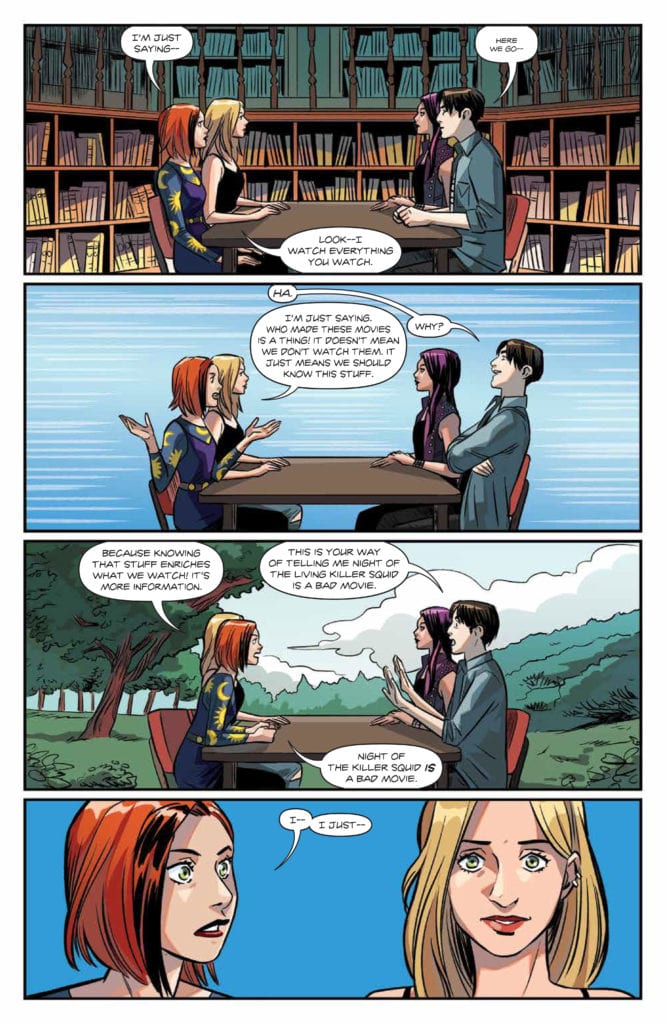Out now, Buffy the Vampire Slayer: Willow #2, subtitled “Belong,” follows the trend of the main Buffy series with a dream sequence. Written by Mariko Tamaki, illustrated by Natacha Bustos, colored by Eleanora Bruni, and lettered by Jodi Wynne, the issue slowly builds with dark symbolism.
In the creative industries, many seasoned professionals advise against ever using dream sequences in any medium. To those pedants, dream sequences are a cheat way of revealing exposition. They also believe the sequences are too esoteric, ruin any sense of realism, and are boring. The list goes on. These are the “rules” of storytelling. But in the Buffyverse, rules are made to be broken.
Fortunately, the supernatural world of Buffy does permit the natural mysticism of the dream. Yet it’s the skill of the writing which elevates the dream sequence from cliché device into poetry in motion.
Dream River
Willow #2 begins with Willow dreaming of a Scooby meeting at the Sunnydale High library. She and Xander argue about a movie, and then Xander transforms into a crow. Dream-Xander breaks the fantasy by calling what it is.
Further down the rabbit hole, the waking world of Abhainn is just as mysterious and surreal for Willow. Real crows follow her, and a conversation with a witch named Aelara gets interrupted by perfect pink roses. By the end of the issue, Willow surmises that Abhainn is a town full of witches. It’s basically one giant coven.
The surreal symbolism of crows and roses matches the spellbound atmosphere of Abhainn. Willow’s point of view further grounds the place, and Dream-Xander breaking the spell. Ultimately, it’s how cannily Willow’s quirky dialogue and thoughts are portrayed, which make this book successful. Willow’s reactions to her new world make the esoteric feel familiar.

The dream sequence and symbols aren’t necessarily so challenging to unpack, either. For one, Abhainn means “river” in Irish, and rivers often symbolize a liminal space. In Willow’s case, Abhainn lies between reality and subconscious, city and wilderness, magic, and pragmatism.
Crows and Roses
Crows, in Celtic myth, occupy these liminal spaces and have the ability to go between magical realms and earthly dimensions. They also represent transformation and change.
As we all know, roses signify romantic love. But the pink rose, such as Willow finds, according to the language of flowers, speaks of a “lesser affection.”
Part of the magic in this sort of storytelling lies in how the writing and art create a sensory experience. On the second-to-last page, for example, Willow has joined a bonfire party Aelara invited her to. In the full-page scene, bright reflections of flame and red spots swirl around various stages of Willow dancing. She begins in the upper corner of the page and ends with a sweaty, smiling close-up.
The image is near psychedelic, evoking warmth, ecstasy, and comfort. It’s an example of expert collaboration between colorist and illustrator who balance the subtle and the romantic.
Bonfire
After all, this bonfire is a sensual scene meant to convey Willow’s new sense of belonging in Abhainn and her feelings for Aelara. Willow’s close-up is her reacting to Aelara addressing her. The entire time, Willow wears the pink rose she found earlier in the book, perhaps indicating that she still holds a torch for her ex Rose as well as her burgeoning relationship with Aelara.
It’s up to us to interpret these familiar symbols. Willow’s dream might be trying to tell her of Xander’s transformation in the BtVS “Ring of Fire” continuity. Maybe the crows signal Willow’s transformation. Perhaps the pink rose relates to Willow’s ex or a new friendship blooming between her and Aelara.
However, tension and mystery must go somewhere now. Forty-eight pages of suspense over two issues needs now to become more. Willow’s wandering and loss-of-self have built to a natural breaking point. Fortunately, we’re in the hands of Tamaki and Co. Their use of a dream sequence and familiar symbolism prove we’re only visitors in their brilliant world.

